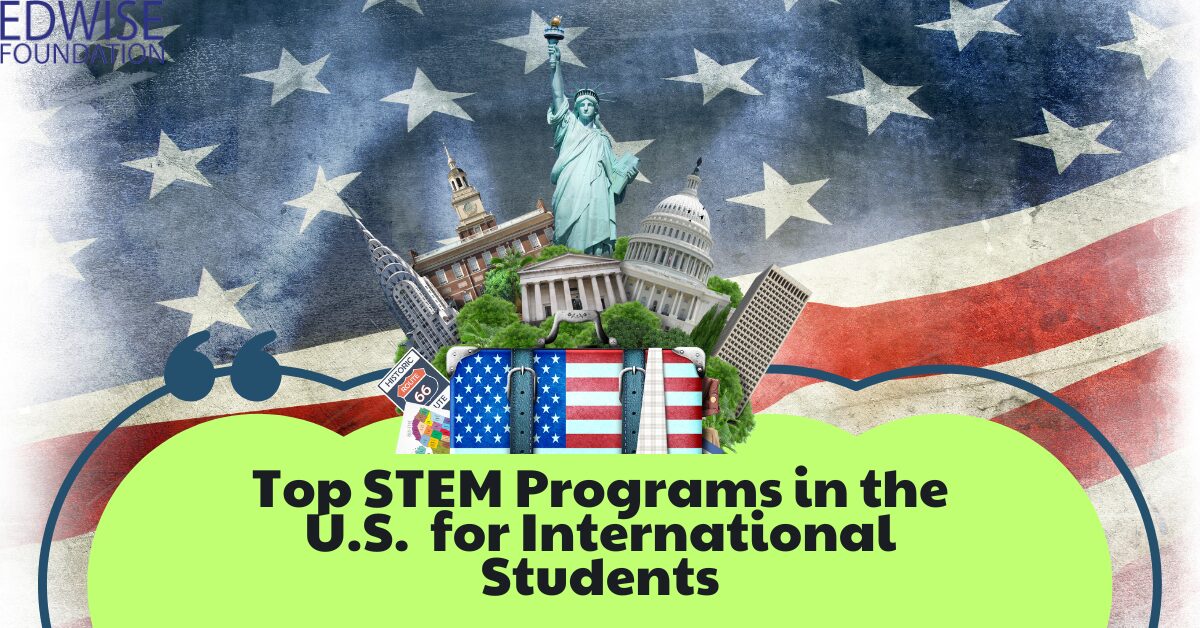Top STEM Programs in the U.S. for International Students

According to the U.S. Department of Homeland Security (DHS), STEM programs consist of four key fields: Science, Technology, Engineering, and Mathematics. These fields focus on creativity, innovation, problem-solving, and critical thinking.
The DHS maintains the STEM Designated Degree Program List, which identifies authorized STEM fields for F-1 students, allowing them an additional 24 months (on top of 12 months) to gain work experience. Further, to qualify for the DHS STEM designation, a program must include at least 50 percent of its coursework in Science, Technology, Engineering, or Mathematics.
Due to the rise of technology and innovation in today’s world, it is beneficial for international students to pursue a career in STEM. STEM graduates often enjoy well-paying jobs, and according to the U.S. Bureau of Labor Statistics (BLS), there is expected to be approximately a 10% increase in STEM-related job opportunities from 2022 to 2032. In short, STEM programs are promising career paths for students who wish to contribute to scientific and technological advancement while also earning a competitive salary.
Top STEM Programs in the U.S. for International Students
There are nearly 350 STEM careers available for students, with the most in-demand programs listed below.
- Data Science: It is a study of information by collecting large sets of data from various sources, and applying data analysis techniques to gain insight. Through this, you can pursue a data scientist position and earn salaries that can rise above $100,000 per year.
- Computer Science: Computer Science is a most desired STEM program due to its work in the design and implementation of computer-based software or components.
- Cybersecurity: This subject is also in demand and can easily help you get a high-paying job as an information security analyst. It focuses on stopping major cyber-attacks and is expected to have a 28% growth by 2026, based on the BLS data.
- Master of Science (MS) in Epidemiology: This STEM-approved program focuses on the development, spread, and control of disease. Epidemiology is a crucial field in public health that helps students learn how to form hypotheses, collect and manage data, use statistical tools, and interpret results.
- Software Development: It focuses on creating the systems that operate on computer devices from desktops to smartphones, building applications, web browsers, databases, word processors, antivirus programs, and audiovisual players
- Actuarial Science: Actuarial science is a specialized financial engineering, as it concentrates solely on analyzing risks and uncertainties, and their known or potential associated costs. In 2024, U.S. News & World Report ranked actuary as the third-best job in the business sector and the eighth-best job in STEM.
- Petroleum Engineering: It focuses on the development, exploration, production, and management of oil and natural gas focusing on areas of modern physics and chemistry to study the characteristics of these fossil fuels.
- Mathematics & Statistics: Mathematics is the abstract science of numbers, quantity, and space. Statistics involves collecting and analyzing numerical data in large volumes, particularly for drawing inferences about proportions from representative samples. This field presents a fascinating blend of mathematical method development and extensive applied work with data.
- Aerospace Engineering: The Aerospace Engineering program is a specialized form of mechanical engineering focusing on aircraft system design. It uses creative thinking skills to solve problems.
- Chemical Engineering: The chemical engineering program covers key subjects like thermodynamics, transport phenomena, kinetics, and applied mathematics. It prepares you to apply the principles of chemistry and design equipment layouts for manufacturing products.
- Biomedical Engineering: This multidisciplinary STEM subject applies a detailed knowledge of modern biological principles in their engineering design process. It combines elements of various fields, including medicine, biology, and engineering. Studies show its 5% projected job employment growth rate in the coming 10 years.
Non-Traditional STEM Courses (ART-Related and Management-Related)
Management-Related STEM Courses
If you want to take the perks of a STEM management course, keep reading to find your ideal program. Management programs blend technical and management skills, making them a bit unique in the STEM field. Depending on the university, some courses may focus on business or leadership while maintaining a strong connection to technology and science, keeping them closely tied to STEM. It is important to confirm with the university to make sure the course is officially recognized as a STEM program, as this can vary from one place and university to another.
- Information Systems Management
Information Systems Management is mostly considered a STEM course. It is heavily reliant on technology, as it focuses on managing IT systems, data, and business processes. In many institutions, it is classified under technology and engineering. However, in some contexts, it might be grouped more with business or management rather than STEM, especially in non-technical business schools.
- Supply Chain Management and Logistics
Depending on the focus, this field is STEM-related but may not always be universally classified under STEM. While logistics involves optimization and technology (data analysis, AI, and systems engineering), it is often viewed as either engineering or business management depending on the context.
- Healthcare Management and Informatics
Healthcare Management can be considered STEM-related, especially when it involves health informatics or medical data science. However, it is often categorized more with healthcare administration when focused on policy and operations.
- Environmental and Sustainability Management
Environmental and Sustainability Management can fall within STEM if it focuses on science (e.g., environmental science, renewable energy technologies) and engineering (e.g., sustainable building, green technologies). However, in some contexts where the focus is more on policy, regulations, or business strategy, it may not be considered a pure STEM field.
Arts Related STEM courses
Arts-related STEM courses, or STEM (A is for Arts), mix creativity with technology. They teach students how to use art and design along with science and technology.
Here are some popular STEM degrees:
- Digital Media and Design
This field of study includes digital inventions’ art and science, including graphic illustration, animation, 3d modeling, digital cinema, and storytelling.
- Game Design and Development
Combines coding, storytelling, and art for video game creation, covering game mechanics, interactive storytelling, and VR design.
- Interactive Media / User Experience (UX) Design
Focuses on creating intuitive digital interfaces and interactive experiences through user research, interface design, and psychology.
- Architectural Engineering / Environmental Design
Blends engineering principles with aesthetics, covering sustainable building design, materials, and structural technology.
- Augmented Reality (AR) / Virtual Reality (VR) Design
Prepares students to design fascinating AR/VR experiences, including 3D modeling, coding, and interactive experience design.
Such degrees prepare the students for the creative industries, such as animation, multimedia business, interactive design, and digital art professions, that require a blend of creativity with technical know-how.
Is an MBA a STEM program?
An MBA program may be designated as STEM at one university but not at another due to differences in curriculum focus. STEM-designated MBA programs focus on subjects like data analytics, technology, or quantitative methods. Some programs offer specialized tracks in Business Analytics, Tech Management, or Operations, which align with STEM fields. Others focus more on traditional management areas, like leadership and organizational behavior. The difference between a STEM MBA program and a traditional MBA depends on how much the program includes STEM-related skills in its coursework.
Reasons why some universities offer MBA as a STEM-designated course:
- Some universities may choose to make their MBA program STEM-designated to attract international students who benefit from the Optional Practical Training (OPT) extension for STEM graduates, which provides additional time to work in the U.S.
- By marketing the MBA as a STEM program, universities can appeal to students interested in technical and analytical skills, particularly those aiming for data-driven or tech-oriented management roles.
- Some MBAs allow students to take elective courses in the STEM field, however, if these courses are not core program requirements, then such programs will not qualify as STEM programs. Universities with a strong quantitative or technical core in their MBA are more likely to gain STEM designation.
Overall, universities must get DHS approval to classify their MBAs as STEM. This involves a formal application that shows the program meets the STEM criteria.
One-Year STEM Courses in the US
Several leading universities in the US offer one-year STEM courses. These names include Harvard University, Stanford University, MIT, Caltech, and others.
These universities offer one-year STEM specializations in diverse fields such as Astronomy, Architectural Engineering, Chemical Engineering, Computer Science, Botany, Behavioral Sciences, Biomedical Technology, Biochemistry, Civil Engineering, and Chemistry, to name a few.
A Major Benefit of STEM Programs
After you finish your program, you can apply for Optional Practical Training (OPT), which lets you work in your field for up to 12 months after graduation. If you graduate from a STEM-designated program, you can extend this time for an extra 24 months, and you could have three years to gain valuable work experience in the U.S.
Factors Behind the Growing Demand for STEM Programs
- Best paying Jobs: A 2023 survey found that 90 out of 100 STEM jobs offer salaries higher than the average. Some of the top-paying fields include petroleum engineering, architecture, and computer engineering. According to the National Association of Colleges and Employers (NACE) and the U.S. Bureau of Labor Statistics (BLS), the best-paying college majors are mostly in STEM. Plus, the BLS expects STEM job opportunities to grow by 10% from 2022 to 2032.
- Core Skills: Studying STEM in the U.S. offers three core soft skills: critical thinking, collaboration, and problem-solving. These skills help students learn to use technology effectively and solve real-world problems.
STEM education can give students from around the globe the skills they need to succeed in a wide range of careers. After choosing your preferred STEM course, make the most of your experience by taking advantage of research works. Get involved in research projects to deepen your knowledge. Participate in career fairs and workshops to learn about job opportunities and connect with potential employers. Meet people in your field to open up future job chances.
Further, Internships can provide valuable hands-on experience and lead to job offers. For professional help, feel free to reach out to our international education experts at Edwise Foundation.



